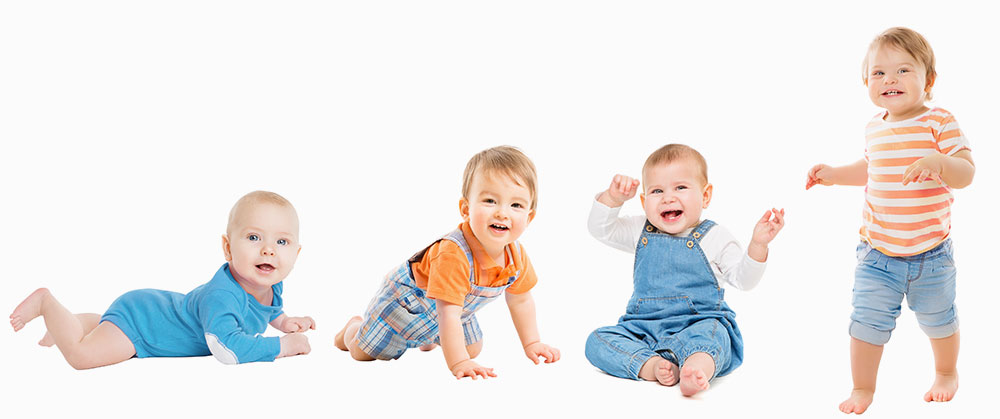
Watching your child grow is incredible. The early years are filled with firsts – first smile, first step, first word. Each represents a developmental milestone, which usually comes in a predictable pattern. This guide outlines the major milestones of the early child development stages.
You should see your child reach them on a roughly similar timeline to the one set out here. Similar doesn’t mean identical, though. Children are unique and develop in their own way. But if there is a significant delay, it may be a sign something’s wrong.
The Five Child Development Stages
Early years are crucial. Your child’s brain will be around 90% grown by the age of five – a seemingly impressive fact that’s gobsmackingly obvious when you compare a newborn to a five-year-old. Children go through incredible leaps in those first five years, from entirely dependent newborns to less dependent young children.
Doctors and theorists have historically recognised the significance of the early years and there’s been a wealth of research into those critical 60 months. This research produced the concept of child development stages – the theorised ‘normal’ sequence of milestones. Although there’s some disagreement, most experts recognise five stages of development, namely:
- Newborn (0–3 months)
- Infant (3–12 months)
- Toddler (1–3 years)
- Pre-school (3–4 years)
- School-age (4–5 years)
For each of these stages, there are anticipated milestones for cognitive, emotional and physical child development. But stages are based on what’s observed in most children, not all of them. There’s every chance your child will reach milestones later than others or in a different order, which is absolutely fine. You should only be worried if there are substantial delays.
Missing Child Development Milestones
Growing up is an exciting phenomenon. The only thing you can be sure of is that it’s a one-way process. Everything else is flexible. Your child’s development won’t necessarily follow the typical path. It’s natural to feel worried when this happens, especially if other parents around you are seeing their children consistently hitting milestones as expected. But try not to panic. It’s almost definitely fine.
Some children even miss milestones entirely. It’s not unheard of for infants to go straight from sitting up to walking, skipping those weeks of wobbly steps supported by a sofa or parent’s hand. Of course, in this situation, it would seem like a developmental delay until the child finally starts walking. So, take everything written here as general guidance. There’s no deadline for development and comparing children is decidedly unhelpful.

Newborn (0–3 Months)
Child development milestones are relatively minor in the first three months. A newborn can react to the world around them – turning their head towards sounds or tracking movement with their eyes, for example. They should also have a range of reflexes. These are tested in the newborn physical check in the first 72 hours, so don’t worry too much about them.
Steady weight gain is one of the more significant physical milestones. While it’s normal for a baby to lose weight in the first few days after birth, they should regain it soon if they feed well. After about three weeks, a healthy baby should be heavier than at birth.
The first few feeds can be extremely trying for mother and baby. For example, a consistently weak latch may indicate a genetic disorder, Prader-Willi Syndrome.
Infant (3–12 Months)
Compared to the first three months, the following nine are typically packed with milestones, so we’ve broken them down into four phases.
Four Months
Your child’s neck control should be improving and they should be able to reach out for items close by and hold their hands together.
You should also start to see your first smiles at this age.
Six Months
Most six-month-olds have developed enough to sit up on their own. They may also be able to move into a crawling position and roll over from their back to their tummy. Playing with your child while on their front – known as tummy time – really helps development. It strengthens their crawling muscles and could help your baby sit up if they haven’t already.
You’ll also likely see more smiles, joined by the occasional babble or spoken sound – usually a ‘da’ or similar noise.
Nine Months
Your child will likely be able to get into a sitting position independently around this age. Nine-month-olds can typically pull themselves up to a standing position, too. And this development in upper-body strength should allow your child to crawl.
Early sounds and syllables are probably coming more frequently. Your baby should also recognise and react positively to familiar people.
Twelve Months
Sitting, crawling and standing with support should all be commonplace by the end of the first year. Your child is probably also cruising – using furniture or other supports to move around upright. It’s not unheard of for infants to stand or even walk unaided at this point.
Your child’s first word might also come around this age, or at least sounds will be more meaningful. Pointing at objects is another communication milestone passed around 12 months.
Toddler (1 – 3 Years)
Your child goes through multiple developmental leaps between the ages of one and three, sometimes seemingly changing overnight. But progress isn’t always consistent. It’s not uncommon to glimpse a new ability and then not see it repeated for the next six weeks. This makes tracking milestones only by age somewhat unhelpful in this child development stage. Instead, we’ve categorised them into physical, communication and emotional milestones.
Physical Milestones
You should see an overall improvement in strength and coordination, with independent walking as the most noticeable development. Toddlers are expected to walk before 18 months. You should consult a doctor if your toddler isn’t walking by this age.
Toddlers should also have some ability to feed themselves. This skill should carry over to simple games and other activities like using crayons or pens.
Communication Milestones
Toddlers should be saying recognisable words from around 18 months. They should soon be able to link words with physical objects, such as parts of their body or favourite toys. This awareness allows them to follow simple instructions like ‘pick up your book’ or ‘touch your nose’.
Emotional Milestones
Children will become better at expressing themselves (you will know when they don’t want to do something). They’ll also interact with others more, joining in with games or domestic activities like tidying up. You’ll see this behaviour both when your child’s with you and when they’re with other toddlers.
Pre-School (3 – 4 Years)
The ‘firsts’ tend to drop off at this age. Instead, you see a general refinement of everything that’s come before. Physical child development should be clear, with motor skills significantly improving. Pre-school children can usually throw, catch, jump and run somewhat confidently. Perhaps the most significant milestone will be speaking in complete sentences, with most three-year-olds able to string two or three together in a way that makes logical sense.

School Age (4 – 5 Years)
In the last of those crucial first five years, milestones become less defined. Like the pre-school stage, you don’t see straightforward ‘firsts’. That’s not to say you don’t see a difference in your child. Around this age, children become much more independent and relationships outside their immediate family become more significant. This healthy detachment helps as children join school and rely more on friendships and other adults for emotional support.
Working with School Age Children
Although this guide was written with parents and guardians in mind, anyone who works with children also has a duty of care towards them. Monitoring and encouraging child development is a huge part of early years education, with vulnerable children needing additional care and attention. Offering this support is fundamental to safeguarding, which requires caregivers to promote a child’s well-being as well as prevent abuse.
Our online safeguarding training courses cover three levels depending on your level of responsibility. Level 1 awareness courses outline safeguarding fundamentals everyone who works with children must know. Level 2 courses build on this knowledge for those with greater responsibilities. Level 3 courses cover everything in the previous levels plus more to qualify trainees for lead safeguarding roles. All courses explain how to spot signs of abuse and what to do if you have a concern for a child’s well-being.
About the author(s)






















































































































































































































































































































































































































































































































































